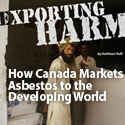Kathleen Ruff, RightOnCanada.ca
The position of the Canadian government is the same as that of the asbestos industry: that chrysotile asbestos can be safely used and that exposure to high levels of chrysotile asbestos does not pose a risk to health.
Health experts, including the Canadian Cancer Society, have repeatedly asked Canada’s Minister of Health to protect Canadians from asbestos harm and to:
- Respect the indisputable scientific evidence and support ending the mining, use and export of asbestos
- Support revision of federal government regulations to say that there is no safe exposure level to any form of asbestos
- Assist First Nations communities to remove asbestos insulation that the federal government placed in their homes and provide compensation for the disease and death this has caused
- Create a national surveillance system to monitor asbestos-related disease in Canada
- Create a national registry of buildings and other locations where asbestos is present
- Remove from government websites misleading and incorrect information on asbestos risk and set up a transparent, ethical process whereby health information on government websites is reviewed by independent experts prior to being disseminated to the public
- Initiate a national information campaign to inform Canadians of the continuing risks posed by all forms of asbestos, as other countries are doing
- Support the provision of economic assistance and retraining to the remaining 340 asbestos miners in Quebec and their community
Health Canada website removes some misinformation
The Canadian government has now allowed its government scientists to remove some misinformation about chrysotile asbestos from the Health Canada website.
The Canadian government under Prime Minister Harper has attacked, dismissed and muzzled government scientists in order to prevent them from putting forward scientific evidence that does not suit the government’s ideological agenda, whether it be on climate change, asbestos or protecting Canada’s lakes and rivers from pollution.
It is good that the Harper government, apparently, accordingly to the government, as part of a general update of government websites, has allowed its government scientists to change a few words on its website regarding harm caused by chrysotile asbestos.
Health Canada website continues to put forward asbestos misinformation
It is important to note, however, that the Health Canada website continues to oppose the recommendation of the World Health Organization that Canadians and populations everywhere stop using products containing chrysotile asbestos in order to protect themselves from asbestos harm.
Even worse, the website continues to put forward appalling misinformation.
The website states:
“The Government of Canada recognizes that breathing in asbestos fibres can cause cancer and other diseases. We help protect Canadians from asbestos exposure by regulating the sale of certain high-risk consumer products made of asbestos or that contain it. This is done through the Asbestos Products Regulations under the Canada Consumer Product Safety Act.”
This is misinformation. Health Canada assures Canadians that government regulations are protecting them from asbestos harm. Nothing could be further from the truth.
Here is the “protection” Canada’s legislation provides
Under the legislation, children’s toys containing asbestos, drywall joint compound containing asbestos and textile fibres containing asbestos are permitted to be imported and sold in Canada, with only the following useless restrictions:
- For an asbestos-containing product that is used by a child in learning or play: Asbestos cannot become separated from the product.
- For drywall joint cement or compound, or spackling or patching compound, that is used in construction, repair or renovation: Asbestos cannot become separated from the product during its post-manufacture preparation, application or removal.
- For a textile fibre product that is worn on the person: A person who uses the product in a reasonably foreseeable manner cannot come into contact with airborne asbestos from the product.
No asbestos-containing product exists that does not deteriorate, get broken or demolished at some point, thus exposing the child playing with the asbestos-containing toy or the worker using asbestos-containing drywall compound or the worker wearing asbestos-containing textile fibre to harm.
Health Canada and the Canadian government continue to provide Canadian with false information and continue to fail to protect Canadians from asbestos harm.
What happens next on asbestos in Canada?
A federal election will be held on October 19, 2015. Parliament is closed. The timing of the change to the information on the Health Canada website means that the government does not have to face questions from the opposition parties in parliament on its asbestos policy.
Government scientists would not be allowed to change information on the government website without political permission to do so, as federal government scientists do not have freedom to speak in Canada. Thus the Harper government is walking both sides of the street. It has allowed its government scientists to correct some asbestos misinformation, while on the political level the government continues its pro-asbestos policy.
In May 2015, the Canadian government rejected the advice of its Health Canada scientific experts and refused to support the listing of chrysotile asbestos as a hazardous substance at the U N Rotterdam Convention Conference of the Parties in Geneva. Instead, the Canadian government sat on the sidelines and remained silent as to whether chrysotile asbestos is a hazardous substance. The international asbestos lobby drew attention to the fact that Canada has not supported the listing of chrysotile asbestos as a hazardous substance.
Whether Canada will ban asbestos depends on the results of the upcoming federal election. Currently, all three major federal parties (Conservative Party, New Democratic Party, Liberal Party) appear to be running neck and neck in the polls.
- New Democratic Party: The New Democratic Party is currently the official opposition party in Canada. It was the first political party in the House of Commons to oppose the use of asbestos. It has called for a ban on the use, import and mining of all forms of asbestos.
- Liberal Party: The Liberal Party, now led by Justin Trudeau, after supporting the use of chrysotile asbestos, then supporting banning its use, then supporting its use, finally took a position supporting a ban on all forms of asbestos.
- Bloq Québéquois: The Bloq Québéquois, while traditionally a strong supporter of the asbestos industry, was then divided on the issue. Gilles Duceppe has returned as its leader after it almost got wiped out in the last federal election. Duceppe has expressed concerns about the export of asbestos but has still supported the industry. The fact that the industry is now closed down in Quebec and that the current Quebec government (the party of former premier Jean Charest) no longer supports the asbestos industry may mean that Duceppe would not oppose a ban on asbestos.
- Green Party: The Green Party is in favour of banning asbestos.
- Conservative Party: The Conservative Party under Prime Minister Harper is ideologically opposed to regulations over industry activities that protect health and the environment. Canada has become recognized for its constant opposition to international efforts to regulate hazardous industries. Harper has expressed his total commitment to supporting the mining and export of asbestos. If the Harper Conservative Party is re-elected in October, it is thus almost certain that it will not ban the mining, use and import of asbestos.



Thu, Jul 2, 2015
Asbestos